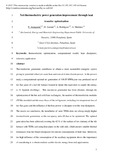Mostrar el registro sencillo del ítem
Net thermoelectric power generation improvement through heat transfer optimization
| dc.creator | Aranguren Garacochea, Patricia | es_ES |
| dc.creator | Astrain Ulibarrena, David | es_ES |
| dc.creator | Rodríguez García, Antonio | es_ES |
| dc.creator | Martínez Echeverri, Álvaro | es_ES |
| dc.date.accessioned | 2017-06-20T10:47:47Z | |
| dc.date.available | 2019-06-25T23:00:10Z | |
| dc.date.issued | 2017 | |
| dc.identifier.issn | 1359-4311 (Print) | |
| dc.identifier.issn | 1873-5606 (Electronic) | |
| dc.identifier.uri | https://hdl.handle.net/2454/24501 | |
| dc.description.abstract | Thermoelectric generation contributes to obtain a more sustainable energetic system giving its potential to harvest waste heat and convert it into electric power. In the present study a computational optimal net generation of 108.05 MWh/year was produced out of the flue gases of a real tile furnace located in Spain (the equivalent to supply the energy to 31 Spanish dwellings). This maximum generation has been obtained through the optimization of the hot and cold heat exchangers, the number of thermoelectric modules (TEMs) installed and the mass flows of the refrigerants, including the temperature loss of the flue gases and the influence of the heat power to dissipate over the heat dissipators. The results are conclusive, the installation of more TEMs does not always imply higher thermoelectric generation, so the occupancy ratio (δ) has to be optimized. The optimal generation has been achieved covering the 42 % of the surface of the chimney of the tile furnace with TEMs and using heat pipes on the cold side, which present smaller thermal resistances than the finned dissipators for similar consumptions of their fans. Moreover, the high influence of the consumption of the auxiliary equipment shows the importance of considering it to obtain realistic usable electric energy from real applications. | en |
| dc.description.sponsorship | The authors are indebted to the Spanish Ministry of Economy and Competitiveness for the economic support to this work, included in the DPI2014-53158-R research project. | en |
| dc.format.mimetype | application/pdf | en |
| dc.language.iso | eng | en |
| dc.publisher | Elsevier | en |
| dc.relation.ispartof | Applied Thermal Engineering 120 (2017) 496–505 | en |
| dc.rights | © 2017 Elsevier Ltd. The manuscript version is made available under the CC BY-NC-ND 4.0 license. | en |
| dc.rights.uri | https://creativecommons.org/licenses/by-nc-nd/4.0/ | |
| dc.subject | Thermoelectric optimization | en |
| dc.subject | Computational model | en |
| dc.subject | Heat dissipators | en |
| dc.subject | Industrial application | en |
| dc.title | Net thermoelectric power generation improvement through heat transfer optimization | en |
| dc.type | Artículo / Artikulua | es |
| dc.type | info:eu-repo/semantics/article | en |
| dc.contributor.department | Ingeniería Mecánica, Energética y de Materiales | es_ES |
| dc.contributor.department | Mekanika, Energetika eta Materialen Ingeniaritza | eu |
| dc.rights.accessRights | Acceso abierto / Sarbide irekia | es |
| dc.rights.accessRights | info:eu-repo/semantics/openAccess | en |
| dc.embargo.terms | 2019-06-25 | |
| dc.identifier.doi | 10.1016/j.applthermaleng.2017.04.022 | |
| dc.relation.projectID | info:eu-repo/grantAgreement/MINECO//DPI2014-53158-R/ES/ | en |
| dc.relation.publisherversion | https://dx.doi.org/10.1016/j.applthermaleng.2017.04.022 | |
| dc.type.version | Versión aceptada / Onetsi den bertsioa | es |
| dc.type.version | info:eu-repo/semantics/acceptedVersion | en |



